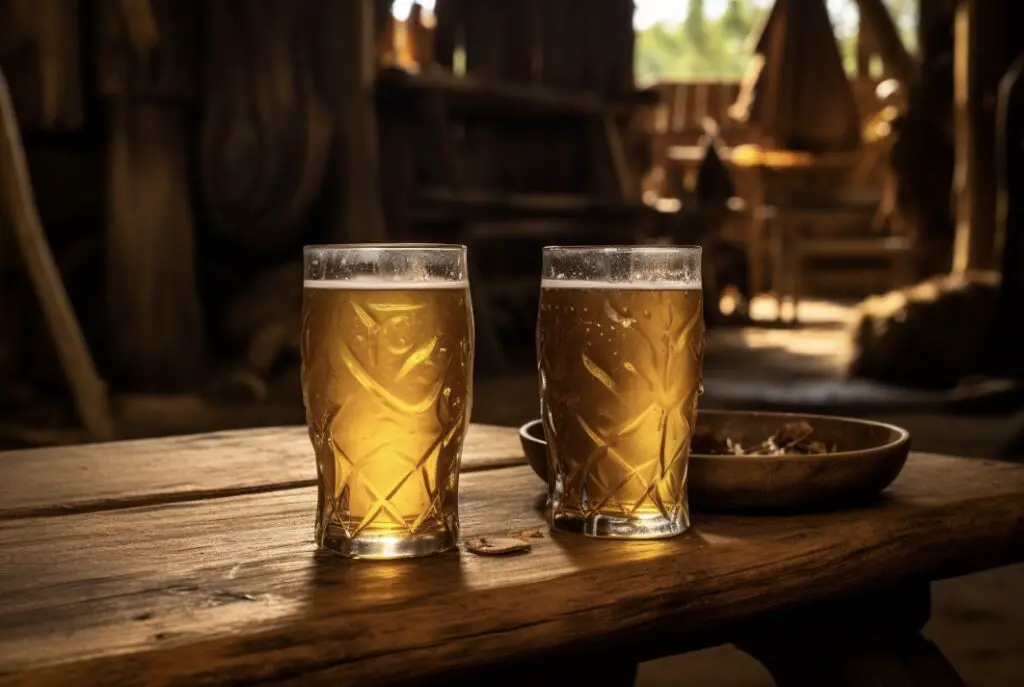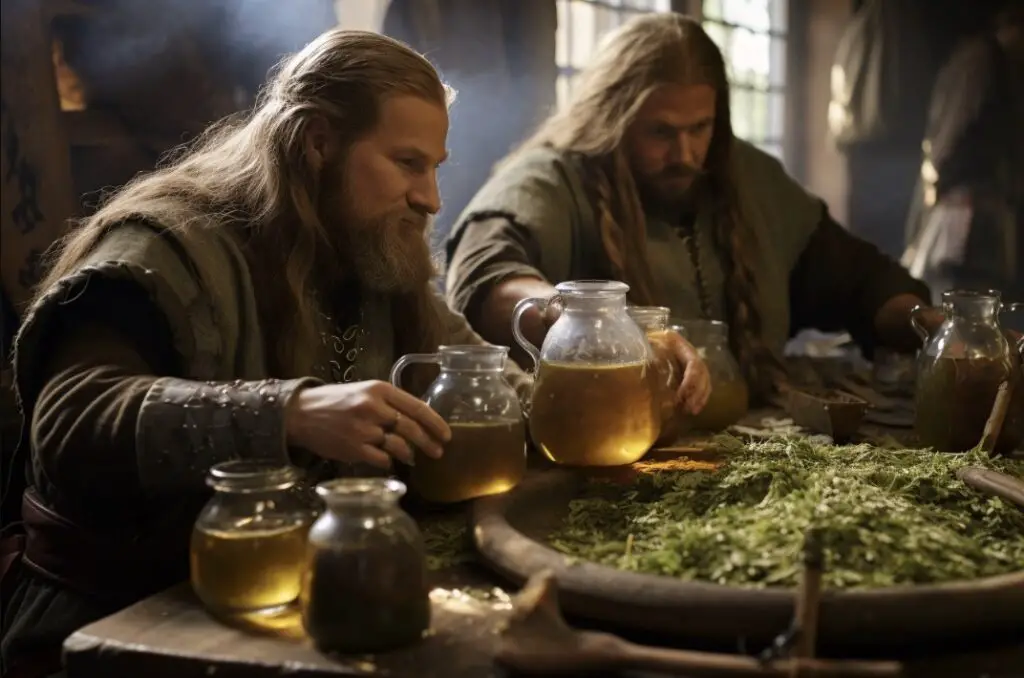It’s a question that often comes up in discussions among fellow brewers and enthusiasts: why don’t we drink mead anymore?
The simple answer is that over the centuries, other beverages like beer, wine, and spirits became more popular due to changes in agricultural practices, tastes, and social habits.
But let’s delve deeper into this fascinating topic.
Do people not drink mead anymore?
Well, it is not as popular as it was during the times of the vikings where not much else was around, but it is, in absolute numbers, drunk by more people than back then!
It is also rising in popularity, but competing with multiple good alternatives.
So one reason is that mead has been overshadowed by other popular alcoholic beverages like wine, beer, and spirits.

These drinks have gained widespread availability and appeal, making them more accessible and familiar to people.
Additionally, the taste of mead can be quite different from what many people are used to. It has a distinct honey flavor that may not be appealing to everyone’s palate. Some individuals prefer the taste of other beverages that are more widely available and have a wider range of flavors.

Moreover, the production of mead can be quite time-consuming and expensive compared to other alcoholic beverages. It requires fermenting honey with water and often involves additional ingredients like fruits, spices, or grains.
This process can be more complex and costly, making mead less commercially viable for some producers.
Overall, the decline in mead consumption can be attributed to a combination of factors including the rise of other popular beverages, personal taste preferences, and the challenges associated with mead production.
A Brief History of Mead
Mead, often referred to as honey wine, is one of the oldest known alcoholic beverages, with a history dating back thousands of years.

Made from honey, water, and yeast, mead was consumed by ancient civilizations in Europe, Africa, and Asia.
The importance of mead can be seen in various historical texts and mythologies. In Norse mythology, for example, mead was considered the drink of the gods and was often associated with wisdom and poetry.
In the medieval period, mead was a common drink in England and was often served at feasts and celebrations.
When was mead most popular?
Mead was most popular during the medieval period, particularly from the 5th to the 12th century.
Mead, an alcoholic beverage created by fermenting honey with water, has a history that dates back thousands of years.
It’s difficult to pinpoint an exact time when mead was most popular, as its popularity has waxed and waned throughout different cultures and eras. However, there are a few periods in history where mead was particularly prominent:
- Ancient Times: Mead is one of the oldest known alcoholic beverages. It was enjoyed by various ancient cultures, including the Greeks, Romans, Egyptians, and Norse. It was often associated with religious rituals and celebrations.
- Medieval Europe: Mead continued to be popular during the Middle Ages in Europe. It was a staple in feasts, celebrations, and social gatherings. Its production was closely tied to the availability of honey and the brewing techniques of the time.
- Renaissance and Early Modern Period: Mead’s popularity endured into the Renaissance and early modern period. However, as the production of other alcoholic beverages like beer and wine became more refined and accessible, mead began to decline in popularity.
- 20th Century Revival: Mead experienced a resurgence in interest in the latter half of the 20th century. This was due in part to the growing interest in historical and traditional foods and beverages. Craft meaderies started to emerge, offering a variety of mead styles and flavors.
- Contemporary Revival: In recent years, mead has been experiencing another revival, with a growing craft mead movement. People are experimenting with different ingredients, flavors, and techniques, leading to a wider range of mead options available to consumers.
While mead may not have maintained a continuous peak of popularity throughout history, its rich cultural and historical significance has ensured that it remains an intriguing and appreciated beverage for enthusiasts around the world.
Factors That Led to the Decline of Mead
Changes in Agricultural Practices
One of the major reasons for the decline of mead is the change in agricultural practices. With the advent of farming, grains became more readily available, leading to the rise of beer as a popular beverage. The cultivation of grapes in regions like Italy and France also led to the popularity of wine.
Cost of Honey Production
Another reason is the cost of honey production. Compared to grains and grapes, honey is more expensive to produce. This made mead a more expensive option compared to beer and wine, contributing to its decline.
Changes in Taste and Preferences
Over time, changes in taste and preferences also played a role in the decline of mead. As new beverages like coffee and tea were introduced, and as spirits like whiskey and rum became popular, mead began to fall out of favor.
The Revival of Mead
Despite its decline, mead is experiencing a revival in recent years. This is partly due to a growing interest in artisanal and craft beverages. Many artisanal breweries and wineries are now producing mead, often experimenting with different flavors and ingredients.

Craft Breweries and Wineries
These craft breweries and wineries are playing a major role in the revival of mead. They are not only producing traditional mead, but also experimenting with various flavors and ingredients, creating a variety of meads that cater to different tastes.
The Popularity of Historical and Fantasy Media
Another factor contributing to the revival of mead is the popularity of historical and fantasy media. Shows like “Game of Thrones” and “Vikings” have sparked an interest in historical beverages, including mead.
The Future of Mead
With its ongoing revival, the future of mead looks promising. As more people discover and appreciate this ancient beverage, it’s likely that mead will continue to gain popularity.
The Role of Homebrewers
Homebrewers are playing a crucial role in the future of mead. With the rise of homebrewing, more people are experimenting with mead production, contributing to its revival.
The Potential for Innovation
The potential for innovation is another factor that bodes well for the future of mead. With so many possible flavor combinations and brewing techniques, there’s a lot of room for creativity in mead production.
In conclusion, the decline of mead can be attributed to changes in agricultural practices, the cost of honey production, and changes in tastes and preferences.
However, with its ongoing revival driven by craft breweries and wineries, the popularity of historical and fantasy media, the role of homebrewers, and the potential for innovation, the future of mead looks promising.
10 Facts About Mead
1. Mead is one of the oldest known alcoholic beverages, dating back thousands of years.
2. It’s made from honey, water, and yeast.
3. Mead was considered the drink of the gods in Norse mythology.
4. The advent of farming led to the rise of beer and wine, contributing to the decline of mead.
5. Honey is more expensive to produce than grains and grapes, making mead a more expensive option.
6. Changes in taste and preferences also contributed to the decline of mead.
7. There is a growing interest in artisanal and craft beverages, contributing to the revival of mead.
8. Craft breweries and wineries are experimenting with different flavors and ingredients to produce a variety of meads.
9. The popularity of historical and fantasy media has sparked an interest in historical beverages, including mead.
10. Homebrewers and the potential for innovation bode well for the future of mead.
In my personal experience as a brewer, I’ve seen a growing interest in mead over the years. It’s been fascinating to see this ancient beverage make a comeback, and I look forward to seeing where this revival leads in the future.
Whether you’re a brewer, a history enthusiast, or just someone who enjoys trying new things, I highly recommend giving mead a try. You might just find your new favorite drink!
FAQs
Do we still drink mead?
Yes, people still drink mead today. It has gained popularity in recent years as a unique and traditional alcoholic beverage made from fermented honey.
Is mead making a comeback?
Yes, mead making is experiencing a resurgence in popularity.
When did mead fall out of fashion?
Mead fell out of fashion during the late Middle Ages and the Renaissance period.




